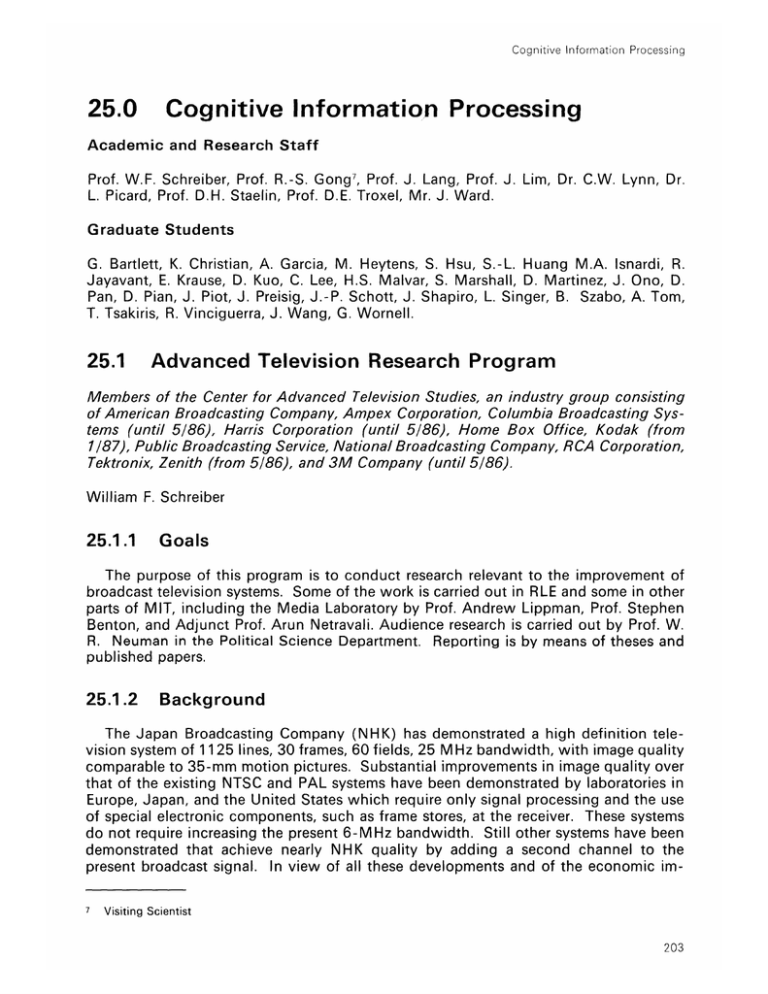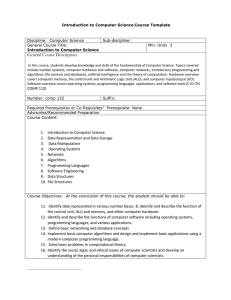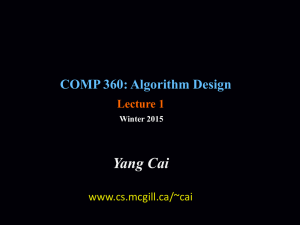25.0 Cognitive Information Processing 25.1
advertisement

Cognitive Information Processing 25.0 Cognitive Information Processing Academic and Research Staff Prof. W.F. Schreiber, Prof. R.-S. Gong7 , Prof. J. Lang, Prof. J. Lim, Dr. C.W. Lynn, Dr. L. Picard, Prof. D.H. Staelin, Prof. D.E. Troxel, Mr. J. Ward. Graduate Students G. Bartlett, K. Christian, A. Garcia, M. Heytens, S. Hsu, S.-L. Huang M.A. Isnardi, R. Jayavant, E. Krause, D. Kuo, C. Lee, H.S. Malvar, S. Marshall, D. Martinez, J. Ono, D. Pan, D. Pian, J. Plot, J. Preisig, J.-P. Schott, J. Shapiro, L. Singer, B. Szabo, A. Tom, T. Tsakiris, R. Vinciguerra, J. Wang, G. Wornell. 25.1 Advanced Television Research Program Members of the Center for Advanced Television Studies, an industry group consisting of American Broadcasting Company, Ampex Corporation, Columbia Broadcasting Systems (until 5/86), Harris Corporation (until 5/86), Home Box Office, Kodak (from 1/87), Public Broadcasting Service, National Broadcasting Company, RCA Corporation, Tektronix, Zenith (from 5/86), and 3M Company (until 5/86). William F. Schreiber 25.1 .1 Goals The purpose of this program is to conduct research relevant to the improvement of broadcast television systems. Some of the work is carried out in RLE and some in other parts of MIT, including the Media Laboratory by Prof. Andrew Lippman, Prof. Stephen Benton, and Adjunct Prof. Arun Netravali. Audience research is carried out by Prof. W. R. Neuman in the Political Science Department. Reporting is by means of theses and published papers. 25.1.2 Background The Japan Broadcasting Company (NHK) has demonstrated a high definition television system of 1125 lines, 30 frames, 60 fields, 25 MHz bandwidth, with image quality comparable to 35-mm motion pictures. Substantial improvements in image quality over that of the existing NTSC and PAL systems have been demonstrated by laboratories in Europe, Japan, and the United States which require only signal processing and the use of special electronic components, such as frame stores, at the receiver. These systems do not require increasing the present 6-MHz bandwidth. Still other systems have been demonstrated that achieve nearly NHK quality by adding a second channel to the present broadcast signal. In view of all these developments and of the economic im7 Visiting Scientist 203 Cognitive Information Processing portance of the US television industry, it was deemed appropriate by the sponsors to fund a research program at an American university. 25.1.3 Research Activities In this contract year, we have completed the assembly of our image-processing system, based on a VAX 11/785, including a high-speed disk subsystem. The latter, which became operational in 1987, permits simulation of full moving high-definition TV sequences. The Audience Research Facility in Danvers, Mass. was also completed, and both of these facilities were used to carry out a variety of studies. Studies have been carried out on motion estimation and perception, optimum filtering, TV system modeling, visual psychophysics, and audience reaction to degraded images and sound. Extensive work has been done in motion estimation, and this has been applied to frame-rate conversion (e.g., 24-fps film to 60-fps TV) and to noise reduction without blurring. Elimination of defects in the US standard (NTSC) TV system by signal processing has also been demonstrated, and some proposed improved TV systems have been simulated. Publications Bartlett, G., "Observations of the Spatial and Temporal Response of Human Color Vision," M.S. Thesis, Dept. Electr. Eng. and Comp. Sci., Cambridge, Mass., 1986. Christian, K., "The Design of an Integrated-Circuit 3D Gaussian Interpolator," M.S. Thesis, Dept. Electr. Eng. and Comp. Sci., M.I.T., Cambridge, Mass., 1985. Hsu, S.C., "The Kell Factor: Past and Present," S.M.P.T.E. 95, 2 (1985). Isnardi, M.A., "Modeling the Television Process," Ph.D. diss., Dept. Electr. Eng. and Comp. Sci., M.I.T., Cambridge, Mass., 1986. Krause, E.A., "Motion Estimation for Frame-Rate Conversion," Ph.D. diss., Dept. Electr. Eng. and Comp. Sci., M.I.T., Cambridge, Mass., 1985. Kuo, D.D., "Design of Dual Frame Rate Image Coding Systems," M.S. Thesis, Dept. Electr. Eng. and Comp. Sci., M.I.T., Cambridge, Mass., 1987. Malvar, H.S., "Optimal Pre- and Post-Filtering in Noisy Sampled Data Systems," Ph.D. diss., Dept. Electr. Eng. and Comp. Sci., Cambridge, Mass., 1986. Martinez, D.M., "Model-Based Motion Estimation and its Application to Motion Pictures," Ph.D. diss., Dept. Electr. Eng. and Comp. Sci., M.I.T., Cambridge, Mass., 1986. Pan, D.Y., "Adaptive Filtering for Sampled Images," Ph.D. diss., Dept. of Electr. Eng. and Comp. Sci., 1986. Schreiber, W.F., "Improved Television Systems: NTSC and Beyond," to be published in S.M.P.T.E. in 1987. 204 R.L.E. P.R. No. 129 Cognitive Information Processing Tom, A., "Prediction of FIR Pre and Post-Filter Performance Based Upon a Visual Model," M.S. Thesis, Dept. Electr. Eng. and Comp. Sci., Cambridge, Mass., 1986. Wang, J.S., "Real-Time Multi-Dimensional Interpolation," M.S. Thesis, Dept. Electr. Eng. and Comp. Sci., M.I.T., Cambridge, Mass., 1986. 25.2 Computer Graphics Donald E. Troxel, Charles W. Lynn, Len Picard, Armando Garcia, Shiao-Li Huang, Joanne Ono, Todd Tsakiris, Ralph Vinciguerra 25.2.1 Display Architecture for Interactive Graphics Programmable Frame Buffer Systems InternationalBusiness Machines, Inc. Our research during the past four years has focused on the architecture of interactive graphics work stations, the user interface, the manipulation of sub-images, and algorithms for shading, texture mapping, and anti-aliasing. We have developed novel shading algorithms suitable for realistic image synthesis on graphics work stations. Hierarchical object modeling and ray tracing techniques are combined with efficient hidden surface algorithms to produce images that approximate the quality of pictures now produced by conventional ray tracing algorithms, but at considerable reduction in computation time. We continue to investigate the problem of producing anti-aliased color displays. 25.2.2 Programmable Frame Buffer Systems InternationalBusiness Machines, Inc. Our research during the past four years has focused on the architecture of interactive graphics work stations, the user interface, the manipulation of sub-images, algorithms for shading, texture mapping, and anti-aliasing, and the raster display itself. This past year we acquired a second IBM PC/XT equipped with a YODA display. One PC/XT is also equipped with a 370 board and appropriate software so that it is possible to compile microcode for the YODA display. We continue to investigate the problem of producing anti-aliased displays in conjunction with our investigation of shading algorithms. There has been considerable literature and increasing use of anti-aliasing in order to generate more pleasing displays for a given spatial sampling grid. This, of course, impacts architectural considerations as the size of the required image refresh memory can be reduced, thus altering the trade-offs. An interesting question concerns the trade-off between the spatial and gray scale resolution; i.e., how should available memory be allocated to optimize quality. The issue of color adds an additional dimension to the problem. Present practice is to apply anti-aliasing algorithms separately to the red, green, and blue separations.This 205 Cognitive Information Processing has the unfortunate effect of producing color fringes on anti-aliased lines.This does not appear to be optimum; however, it is not obvious what color space should be used when calculating anti-aliasing in order to maintain both a pleasing display and true colors. Another way to look at this problem is to ask what trajectory in color space should one use in performing the anti-aliasing computation. The distinction between image processing and graphic systems has been blurred as their hardware architectures have evolved toward each other. We are interested in providing tools and functional capabilities to simplify the task of the applications implementors and also to provide guidance to future hardware architects as to the trade-offs of the parameters of frame buffer systems. These parameters include the number of bit planes in the visible frame buffer, the size and number of bit planes in invisible frame buffers, the number of entries in a video color look up table, the number of bits in each video color look up table entry, and the manner in which the addresses of the video color look up table entries are generated. The basic functional capabilities desired include transparency and anti-aliasing, clipping, zooming (other than by pel replication), and window management (i.e., dynamic overlays, animation, and palindromic sequences for depth cueing). A recently completed PhD thesis by Armando Garcia developed novel shading algorithms suitable for realistic image synthesis on graphics work stations. Hierarchical object modeling and ray tracing techniques are combined with efficient hidden surface algorithms to produce images that approximate the quality of pictures now produced by conventional ray tracing algorithms, but at considerable reduction in computation time. These new algorithms implement rendering, reflection, and shadowing and have been programmed to run on both a DEC VAX-11/750 with an IRIS graphics terminal, and an IBM-PC/XT with the YODA attachment. For the most part, the algorithms are device independent, and simply make use of the IRIS/YODA hardware for drawing polygons and single pixels. 25.3 Computer Aided Fabrication System Structure Defense Advanced Research Agency (Contract N00014-85-K-0213) Donald E. Troxel, Rajeev Jayavant, Michael Heytens The Computer Aided Fabrication (CAF) system structure carried out within RLE is part of a larger project within MTL. The overall goal of the CAF project is to integrate computers into the control, data collection, modeling, and scheduling of the integrated circuit fabrication process. Previously, an initial, rudimentary CAF system was implemented. This included a personal notebook and data structures. During this period we have completed installation of the primary CAF computer, terminal concentrators, wiring of the facility with RS232 ports, and installation of terminals in the fabrication laboratory. We have interfaced to the MIT physical plant computer which monitors a large number of sensing points such as resistance of DI water, etc., in our facility. We capture 206 R.L.E. P.R. No. 129 Cognitive Information Processing all alarms printed, maintain a log of active alarms, and have provided a mechanism for remote query of the status of the monitored points. We have interfaced to some processing and measuring equipment. The Dektak profilometer has been interfaced with the CAF computer and software has been developed for transmitting screen plots and for printing these plots on either a laser printer or terminal. The Nanospec has been interfaced and data collection software installed. We have also provided a connection to the BTU furnace controller both for the creating and downloading of furnace recipes. We have decided to use INGRES as a relational data base and have initiated an active project to define a scheme. We have initiated the development of a process flow language. This language will have a lisp-like form, although this need not be apparent ot process design engineers. The meaning of our process flow language will be provided by several interpreters fabrication, simulation, production scheduling, and a "walk-through" interpreter. The walk-through interpreter will, we think, prove useful in the design of a process, the communication of the process to others, and in its approval by lab management. 207 I 208 R.L.E. P.R. No. 129

